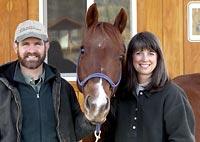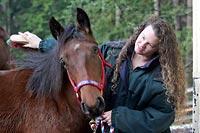Couple offers clearer view of blind horses

When Juliane Hanley first saw the frightened young horse at an Enumclaw auction, it was obvious the filly was blind.
She titled her head in a funny way and kept running into the gate of a stall. "At one point, she ended up falling on her back. It was heartbreaking," said Hanley. And that was before the auctioneer said the horse wasn't worth the cost of grain to feed her and sold her to the "meat man" for $20, Hanley said.
As she sat in the bleachers and the auction wound to a close, Hanley, 31, couldn't stop thinking about the scared filly being led to a gruesome slaughter. She and other members of the Cowgirl Spirit Rescue Drill Team approached the meat man and bought the blind horse from him for $20.
But Hanley, a Microsoft Web developer, didn't know anything about blind horses. Could they have a decent life? Could they be trained? Were they dangerous?
A crusade and a convention
Hanley isn't alone when it comes to such questions, say two former Boeing employees who've founded a nonprofit group dedicated to caring for blind horses and educating Americans about their plight.
Today, Steve Smith and Alayne Marker will bring their crusade to a national convention of 2,500 equine veterinarians meeting in Seattle this week.
Their message is simple. "A blind horse can have a wonderful quality of life if you give it a chance," Smith said.
But he and Marker need to convince some vets of that. "Too often what we've heard from people is that their vet is recommending they euthanize a horse and typically the reason they're given is one of the myths that exists about blind horses," Smith said.
Dr. Dennis Brooks, an expert in equine ophthalmology, agreed that many vets don't know horses can adapt quite well to blindness. "I don't know if it's most vets, but it's enough that they need education," said Brooks, a University of Florida professor. "We have preconceptions about what blindness is. But animals don't. They just deal with it."
Horses have superb vision compared with animals such as dogs and cats. As a natural defense against predators, they have eyes good at detecting motion and seeing in the dark, Brooks said.
It's estimated that 1 percent of the country's 9 million horses are blind in both eyes. "It's a common problem. Every horse owner will know of a blind horse," Brooks said.
The leading cause of blindness is equine uveitis, an autoimmune disease that stems from infections, Brooks explained.
Life isn't over
Too often, when a horse goes blind it means the end of its life. People assume a 1,000-pound animal that can't see is going to be dangerous, Smith said.
"What we think happens for many vets is that they're called in when a horse is suddenly going blind. They see it frightened and panicky and they extrapolate that that behavior is going to be forever. But it's not. Ultimately, most horses adjust well to blindness," he added.
Some horses will never adjust, Smith acknowledged, but that results more from the horse's high-strung personality or lack of proper care than from the blindness itself.
Smith knows from hands-on experience. When he and Marker, his wife, quit their Boeing jobs five years ago to open a sanctuary for disabled animals in Montana, they assumed they'd be mainly dealing with dogs and cats.
"It never occurred to us we'd end up with blind horses. As it turned out, our first resident was Lena," Smith said.
An 8-year-old quarter-horse, Lena is totally and permanently blind. When she first arrived at Smith and Marker's 160-acre ranch, she appeared nervous and was covered with scabs and scars inflicted by other horses that had bullied her.
But in time she became familiar with their voices. She would let them lead her anywhere as they walked at her side and talked. She became calm and gentle. The scabs and scars faded. Now, they say, she exudes a confidence that comes from knowing her surroundings.
Few special needs
Horses like Lena make a mental map of their environments, Smith said, and maneuver well if objects aren't moved on them. Others rely on a buddy horse they stay close to as they walk in a pasture or corral.
"They're very conservative. They know they can't see, and they don't want to get hurt, so they're very cautious," he said.
In all, Smith and Marker care for 20 blind horses at their Rolling Dog Ranch Animal Sanctuary. (You can meet most of them at www.blindhorses.org.) They include Madison and Bridger, an inseparable couple, according to Smith.
"They love each other, dote on each other. They're totally blind but they have an absolute, undying devotion to each other," he said.
Smith and Marker say blind horses don't require much special attention. All you have to do differently, they say, is keep a blind horse away from horses that bully it. You should also use safe fencing — smooth wire mesh instead of barbed or electrified wire. And you should make sure pastures are free of holes, low-hanging tree limbs and other potential dangers.
An important role
Hanley has received quite an education in the nine months since she saved the frightened filly, now called Spirit.
Mostly, she's learned how rewarding it is to own a blind horse. "Because they can't see, they rely on you. There's definitely a much deeper level of trust and bonding with a blind horse," she said.
Spirit has turned out to be cuddly. "She's very puppy-like. She loves to be near people. She loves to be touched, scratched and hugged. She's turned out to be a very emotional and sensual horse," Hanley said.
Now, Spirit is sort of a mascot and ambassador for the Sammamish-based Cowgirl Spirit Rescue Drill Team, a nonprofit group that rescues horses, trains them and competes against other drill teams in Washington state.
"We have taken her to many fundraisers. Even though she's blind, she goes to strange new environments with strange people and cars going by," Hanley said.
Still, Hanley said, she has much to learn about blind horses. She wants to know more about their behaviors and needs, the best ways to care for them, and whether Spirit's sight can be restored through surgery. The rescue drill team is setting up a booth next to Smith and Marker's at the American Association of Equine Practitioners' convention and trade show that began Saturday and runs through Wednesday in Seattle.
This will mark the first such convention Smith has attended. "I just want to make sure the veterinary community has access to all this information we've put together about blind horses," he said. "Our idea is that a horse is not a disposable product that you send off to slaughter when you can't use it anymore. It's time we start looking at horses the same way we look at other companion animals," he said.
He won't get an argument from Hanley. "Spirit will be with us forever," she said. "We will never adopt her out."
Bob Young: 206-464-2174 or byoung@seattletimes.com

Myths, tips![]()
![]()
Myth No. 1: A blind horse can't have a good quality of life.
Myth No. 2: A blind horse is dangerous.
Myth No. 3: A blind horse takes a lot more work to care for than a sighted horse.
Myth No. 4: You can't put a blind horse out to pasture.
Myth No. 5: Blind horses aren't good for anything
Tip No. 1: Get the best veterinary care possible.
Tip No. 2: Give the horse time to adjust to blindness.
Tip No. 3: Keep the horse out of a herd.
Tip No. 4: Use safe fencing.
Tip No. 5: Inspect pastures for obstacles and hazards.
Source: Blindhorses.org